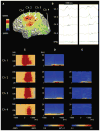Ictal high-frequency oscillations at 80-200 Hz coupled with delta phase in epileptic spasms
- PMID: 21972918
- PMCID: PMC3674760
- DOI: 10.1111/j.1528-1167.2011.03263.x
Ictal high-frequency oscillations at 80-200 Hz coupled with delta phase in epileptic spasms
Abstract
Previous studies of epileptic spasms reported that ictal events were associated with high-frequency oscillations (HFOs) or delta waves involving widespread regions. We determined whether ictal HFOs at 80-200 Hz were coupled with a phase of slow-wave, whether ictal slow-waves were diffusely or locally synchronous signals, and whether the mode of coupling between HFOs and slow-wave phases differed between ictal and interictal states. We studied 11 children who underwent extraoperative electrocorticography (ECoG) recording. The phases and amplitudes of slow-waves were measured at the peak of ictal and interictal HFOs in the seizure-onset sites. Ictal HFOs were locked tightly to the phase of slow-wave at ≤1 Hz. Ictal slow-waves propagated from the seizure-onset site to other regions. In contrast, interictal HFOs in the seizure-onset site were loosely locked to the phase of slow-wave at ≤1 Hz but tightly to that of ≥3-Hz. Ictal slow-waves coupled with HFOs can be explained as near-field and locally synchronized potentials generated by the neocortex rather than far-field potentials generated by subcortical structures. Ictal slow-waves in epileptic spasms may be generated by a mechanism different from what generates interictal HFOs-slow-wave complexes.
Wiley Periodicals, Inc. © 2011 International League Against Epilepsy.
Conflict of interest statement
None of the authors has any conflict of interest to disclose. We confirm that we have read the Journal’s position on issues involved in ethical publication and affirm that this report is consistent with those guidelines.
Figures


Similar articles
-
Epileptic spasms in older pediatric patients: MEG and ictal high-frequency oscillations suggest focal-onset seizures in a subset of epileptic spasms.Epilepsy Res. 2008 Feb;78(2-3):216-24. doi: 10.1016/j.eplepsyres.2007.12.007. Epub 2008 Jan 22. Epilepsy Res. 2008. PMID: 18215506
-
Statistical mapping of ictal high-frequency oscillations in epileptic spasms.Epilepsia. 2011 Jan;52(1):63-74. doi: 10.1111/j.1528-1167.2010.02786.x. Epub 2010 Nov 18. Epilepsia. 2011. PMID: 21087245 Free PMC article.
-
Dynamic changes of ictal high-frequency oscillations in neocortical epilepsy: using multiple band frequency analysis.Epilepsia. 2007 Feb;48(2):286-96. doi: 10.1111/j.1528-1167.2007.00923.x. Epilepsia. 2007. PMID: 17295622
-
How to establish causality in epilepsy surgery.Brain Dev. 2013 Sep;35(8):706-20. doi: 10.1016/j.braindev.2013.04.004. Epub 2013 May 15. Brain Dev. 2013. PMID: 23684007 Free PMC article. Review.
-
DC shifts, high frequency oscillations, ripples and fast ripples in relation to the seizure onset zone.Seizure. 2020 Apr;77:52-58. doi: 10.1016/j.seizure.2019.05.001. Epub 2019 May 3. Seizure. 2020. PMID: 31101405 Free PMC article. Review.
Cited by
-
Scalp EEG interictal high frequency oscillations as an objective biomarker of infantile spasms.Clin Neurophysiol. 2020 Nov;131(11):2527-2536. doi: 10.1016/j.clinph.2020.08.013. Epub 2020 Sep 3. Clin Neurophysiol. 2020. PMID: 32927206 Free PMC article.
-
High gamma activity of 60-70 Hz in the area surrounding a cortical tuber in an infant with tuberous sclerosis.Ital J Pediatr. 2012 May 3;38:15. doi: 10.1186/1824-7288-38-15. Ital J Pediatr. 2012. PMID: 22553953 Free PMC article.
-
Transcutaneous Cervical Vagus Nerve Stimulation Induces Changes in the Electroencephalogram and Heart Rate Variability of Healthy Dogs, a Pilot Study.Front Vet Sci. 2022 Jun 13;9:878962. doi: 10.3389/fvets.2022.878962. eCollection 2022. Front Vet Sci. 2022. PMID: 35769324 Free PMC article.
-
Phase-amplitude coupling and epileptogenesis in an animal model of mesial temporal lobe epilepsy.Neurobiol Dis. 2018 Jun;114:111-119. doi: 10.1016/j.nbd.2018.02.008. Epub 2018 Feb 24. Neurobiol Dis. 2018. PMID: 29486299 Free PMC article.
-
Vigabatrin therapy implicates neocortical high frequency oscillations in an animal model of infantile spasms.Neurobiol Dis. 2015 Oct;82:1-11. doi: 10.1016/j.nbd.2015.04.019. Epub 2015 May 27. Neurobiol Dis. 2015. PMID: 26026423 Free PMC article.
References
-
- Fusco L, Vigevano F. Ictal clinical electroencephalographic findings of spasms in West syndrome. Epilepsia. 1993;34:671–678. - PubMed
-
- Hoechstetter K, Bornfleth H, Weckesser D, Ille N, Berg P, Scherg M. BESA source coherence: a new method to study cortical oscillatory coupling. Brain Topogr. 2004;16:233–238. - PubMed
-
- Kakisaka Y, Haginoya K, Ishitobi M, Togashi N, Kitamura T, Wakusawa K, Sato I, Hino-Fukuyo N, Uematsu M, Munakata M, Yokoyama H, Iinuma K, Kaneta T, Higano S, Tsuchiya S. Utility of subtraction ictal SPECT images in detecting focal leading activity and understanding the pathophysiology of spasms in patients with West syndrome. Epilepsy Res. 2009;83:177–183. - PubMed
-
- Kellaway P, Hrachovy RA, Frost JD, Zion T. Precise characterization and quantification of infantile spasms. Ann Neurol. 1979;6:214–218. - PubMed

